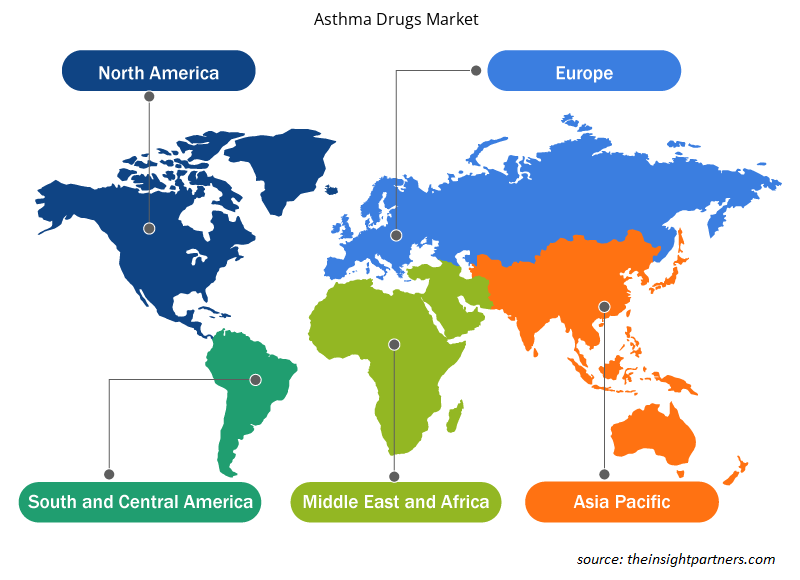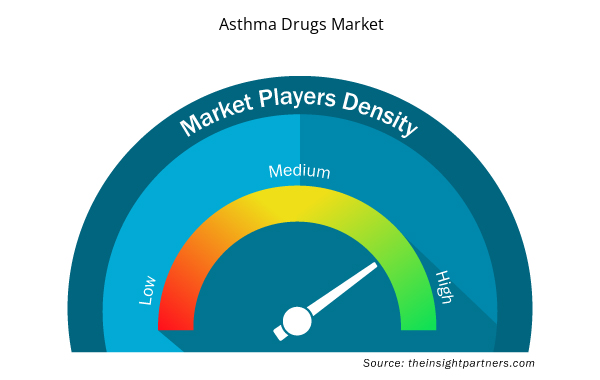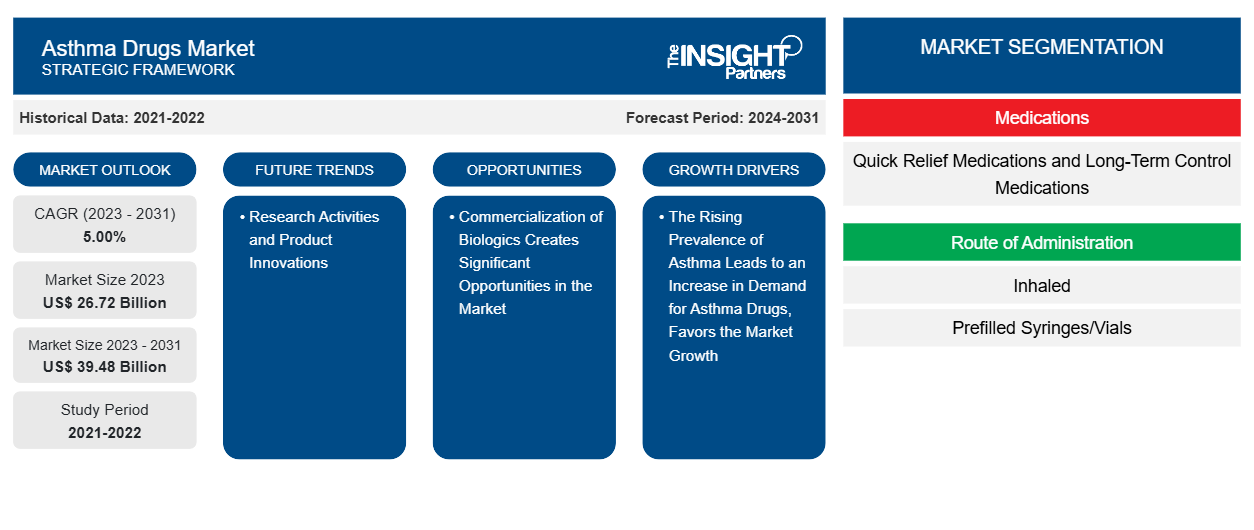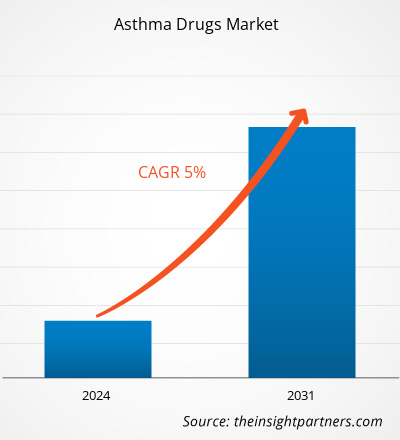Der Markt für Asthmamedikamente soll von 26,72 Milliarden US-Dollar im Jahr 2023 auf 39,48 Milliarden US-Dollar im Jahr 2031 anwachsen. Für den Zeitraum 2023–2031 wird ein durchschnittliches jährliches Wachstum von 5,00 % erwartet. Forschungsaktivitäten und Produktinnovationen werden voraussichtlich weiterhin ein wichtiger Trend auf dem Markt bleiben.CAGR of 5.00% during 2023–2031. Research activities and product innovations will likely remain a key trend in the market.
Marktanalyse für Asthmamedikamente
Die Nachfrage nach wirksamen Asthmabehandlungen steigt aufgrund der weltweit zunehmenden Zahl von Asthmaerkrankungen dramatisch an. Diese werden durch Faktoren wie Umweltverschmutzung, Veränderungen des Lebensstils und genetische Veranlagung verursacht. Die Behandlungsergebnisse der Patienten werden durch kontinuierliche Innovationen bei der Formulierung und Verabreichung von Medikamenten verbessert. Patienten mit schwerem Asthma haben jetzt individuellere und wirksamere Behandlungsmöglichkeiten, da Biologika entwickelt werden, die auf bestimmte molekulare Signalwege abzielen. Aufgrund der raschen Urbanisierung, des wachsenden Bewusstseins und der Verbesserung der Gesundheitsinfrastruktur bieten sich in Schwellenmärkten wie dem asiatisch-pazifischen Raum, Lateinamerika und einigen Regionen Afrikas viele Wachstumsaussichten. Ein verbesserter Zugang zu Gesundheitsdiensten und steigende verfügbare Einkommen in diesen Regionen unterstützen ebenfalls die Marktexpansion.biologics that target particular molecular pathways. There are a lot of growth prospects in emerging markets like Asia-Pacific, Latin America, and some regions of Africa due to rapid urbanization, expanding awareness, and bettering healthcare infrastructure. Improved access to healthcare services and rising disposable incomes in these areas also support market expansion.
Marktübersicht für Asthmamedikamente
Moderne Inhalatortechnologie, wie intelligente Inhalatoren mit digitalen Gesundheitsfunktionen, verbessert die Medikamenteneinnahmetreue und bietet wertvolle Informationen für ein besseres Asthmamanagement. Die Nachfrage nach Asthmamedikamenten wird durch verbesserte Schulungen des Gesundheitspersonals, Aufklärungsinitiativen für Patienten und öffentliche Gesundheitskampagnen zur Sensibilisierung für Asthma und dessen Behandlung angetrieben. Infolgedessen wird der Markt wahrscheinlich aufgrund der steigenden Nachfrage nach Medikamenten zur Behandlung von Asthma wachsen. Der Markt wächst aufgrund günstiger regulatorischer Rahmenbedingungen und schneller Zulassungsverfahren für neuartige und kreative Asthmabehandlungen. Die Verbesserung des Asthmamanagements und der Pflegestandards ist ein weiterer Bereich, auf den sich Regierungen und Aufsichtsbehörden immer mehr konzentrieren.favourable regulatory frameworks and quick approval procedures for novel and creative asthma treatments. Improving asthma management and care standards is another area that governments and regulatory agencies are concentrating on more and more.
Passen Sie diesen Bericht Ihren Anforderungen an
Sie erhalten kostenlos individuelle Anpassungen an jedem Bericht, einschließlich Teilen dieses Berichts oder einer Analyse auf Länderebene, eines Excel-Datenpakets sowie tolle Angebote und Rabatte für Start-ups und Universitäten.
- Holen Sie sich die wichtigsten Markttrends aus diesem Bericht.Dieses KOSTENLOSE Beispiel umfasst eine Datenanalyse von Markttrends bis hin zu Schätzungen und Prognosen.
Markttreiber und Chancen für Asthmamedikamente
Die steigende Prävalenz von Asthma führt zu einer erhöhten Nachfrage nach Asthmamedikamenten und begünstigt das Marktwachstum
Chronisches Asthma ist eine Atemwegserkrankung, die durch Entzündungen der Atemwege, Überempfindlichkeit der Bronchien und variable Atemwegsbeschränkung gekennzeichnet ist. Luftverschmutzung verschlechtert Asthma bei Erwachsenen und Kindern, so ein Übersichtsartikel mit dem Titel „Auswirkungen der Luftverschmutzung auf Asthma“ von Tiotiu et al. Verkehrsbedingte Luftverschmutzung, Stickstoffdioxid (NO2) und Passivrauchen (SHS) sind erhebliche Risikofaktoren für die Entwicklung von Asthma bei Kindern. Die Belastung durch äußere Verschmutzung kann Asthmasymptome, Verschlimmerungen und eine verringerte Lungenfunktion verursachen. Asthma und Luftverschmutzung sind in den USA immer noch miteinander verbunden. Über 23 Millionen Amerikaner leiden an dieser schweren, potenziell tödlichen chronischen Atemwegserkrankung. Asthmatiker können Anfälle erleiden, da die Luftverschmutzung ihre Symptome verschlimmert. Verschmutzung stellt eine besondere Bedrohung für Kinder mit Asthma dar, von dem in den USA etwa 6 Millionen Kinder betroffen sind. Die Auswirkungen der Luftverschmutzung auf zwei Gene, die mit der immunologischen Toleranz bei Kindern aus stark verschmutzten Gebieten in Zusammenhang stehen, wurden von Forschern des Children's Center der Stanford University untersucht. Sie fanden heraus, dass Veränderungen in diesen beiden Genen zu Asthma führten und dass die Belastung durch hohe Konzentrationen von Kohlenmonoxid (CO), NO2 und PM2,5 (Partikelstaub) sowohl mit kurzfristigen als auch langfristigen Veränderungen in diesen Genen verbunden war. Die Entwicklung präventiver Asthmamedikamente könnte von diesen Erkenntnissen profitieren, die sich auf die epigenetischen Auswirkungen der Belastung durch Luftverschmutzung konzentrierten. Jede dieser Studien zu Asthma hat unser Wissen über die Krankheit bei Kindern erweitert und der EPA wichtige Daten geliefert, die sie zum Schutz der menschlichen Gesundheit und der Umwelt nutzen kann. Der Markt für Asthmamedikamente wird durch die beschleunigte Arzneimittelentdeckung und -entwicklung für Asthma getrieben, die durch diese Forschungsprojekte herbeigeführt wurde.hyperresponsiveness, and variable airflow restriction. Air pollution impeded asthma outcomes in adults and children, according to a review paper titled "Impact of Air Pollution on Asthma Outcomes" by Tiotiu et al. Traffic-related air pollution, nitrogen dioxide (NO2), and secondhand smoke (SHS) are significant risk factors for children's asthma development. Exposure to external pollution can cause asthma symptoms, exacerbations, and reduced lung function. Asthma and exposure to air pollution are still linked in the US. Over twenty-three million Americans suffer from this severe, potentially fatal chronic respiratory illness. People who have asthma may experience attacks due to air pollution exacerbating their symptoms. Pollution poses a particular threat to children who have asthma, which affects approximately 6 million children in the US. The impact of air pollution on two genes related to immunological tolerance in children from high-pollution areas was studied by Stanford University's Children's Center researchers. They found that alterations in these two genes led to asthma and that exposure to high concentrations of carbon monoxide (CO), NO2, and PM2.5 (particulate matter) was associated with both short- and long-term changes in these genes. The development of preventative asthma medications may benefit from these findings, which concentrated on the epigenetic effects of exposure to air pollution. Every one of these studies on asthma has advanced our knowledge of the condition in children and provided the EPA with vital data that it can utilize to safeguard both human health and the environment. The asthma medication market is being driven by the accelerated drug discovery and development for asthma brought about by these research projects.
Kommerzialisierung von Biologika schafft erhebliche MarktchancenBiologics Creates Significant Opportunities in the Market
Viele Asthmatiker haben festgestellt, dass die Einnahme eines oralen oder inhalierten Kontrollmedikaments, die Vermeidung von Auslösern und die Verwendung eines schnell wirkenden Inhalators bei aufflammenden Symptomen ausreichen, um ihr Asthma in den Griff zu bekommen. Für manche Menschen reichen diese Medikamente jedoch nicht aus, um ihr Asthma zu behandeln. Vor kurzem wurden mehrere innovative Medikamente, sogenannte „Biologika“, zur Behandlung von mittelschwerem bis schwerem Asthma zugelassen. Im Gegensatz zu anderen Medikamenten zielen Biologika auf einen bestimmten Antikörper, ein Molekül oder eine Zelle ab, die mit Asthma in Zusammenhang stehen. Biologika werden daher als Präzisions- oder maßgeschneiderte Therapie bezeichnet. Ein Biologikum ist ein Medikament, das auf bestimmte Moleküle im Menschen abzielt, die aus den Zellen eines lebenden Organismus wie Bakterien oder Mäusen gewonnen werden. Asthma-Biologika zielen auf Zellrezeptoren, Entzündungschemikalien und Antikörper ab. Indem sie sich auf diese Moleküle konzentrieren, zielen Biologika darauf ab, die Mechanismen zu stören, die zu Entzündungen führen, die die Asthmasymptome verschlimmern. Patienten, die nach der Einnahme ihrer regelmäßigen täglichen Kontrollmedikamente immer noch Symptome haben, werden Biologika verschrieben. Wiederholte Krankenhauseinweisungen, Besuche in der Notaufnahme oder die Notwendigkeit oraler Steroide bei Exazerbationen sind Anzeichen für schlecht kontrolliertes Asthma. Der Hauptvorteil von Biologika ist die Verringerung der Anzahl von Asthmaanfällen, was zu weniger Besuchen in der Notaufnahme und Krankenhausaufenthalten sowie dem Bedarf an oralen Steroiden geführt hat. Weitere Vorteile von Biologika sind eine Verringerung der Asthmasymptome, weniger Fehltage bei der Arbeit und in der Schule sowie niedrigere Dosierungen anderer Kontrollmedikamente.biologics," were granted a license to treat moderate-to-severe asthma. Unlike other drugs, biologics target a particular antibody, molecule, or cell implicated in asthma. Biologics are therefore referred to as precision or customized therapy. A biologic is a medication designed to target particular molecules in humans derived from the cells of a living organism, such as bacteria or mice. Asthma biologics target cell receptors, inflammatory chemicals, and antibodies. By focusing on these molecules, Biologics aims to interfere with the mechanisms that lead to inflammation, which aggravates asthma symptoms. Patients who still experience symptoms after taking their regular daily controller medications are prescribed biologics. Recurrent hospital admissions, ER visits, or the need for oral steroids for exacerbations are signs of poorly controlled asthma. Biologics' primary benefit has been a decrease in the number of asthma exacerbations, which has resulted in fewer ER visits, hospital stays, and the requirement for oral steroids. Other benefits of biologics include decreased asthma symptoms, fewer missed workdays and school, and lower dosages of other controller medications.
Die Lebensqualität von Asthmapatienten wird durch Biologika verbessert. Berichten zufolge können bestimmte Biologika Patienten mit schwerem Asthma dabei helfen, die Lungenfunktion zu verbessern. Derzeit sind Omalizumab, Mepolizumab, Reslizumab, Benralizumab und Dupilumab die fünf zugelassenen Biologika für Asthma. Omalizumab ist ein Antikörper, der sich explizit gegen IgE-Allergie-Antikörper richtet. Bevacizumab, Mepolizumab und Reslizumab richten sich gegen eine Untergruppe von Zellen, die als Eosinophile bezeichnet werden. Sie sind an allergischen Entzündungen beteiligt. Ein monoklonaler Antikörper namens Dupilumab bindet an einen Rezeptor für zwei Moleküle, die allergische Entzündungen hervorrufen. Ein Arzt wird Screening-Tests wie Blutuntersuchungen oder Hautstichproben auf Umweltallergene anordnen, um festzustellen, welches Biologikum die wirksamste Asthmabehandlung sein könnte. Omalizumab ist für Patienten ab sechs Jahren zugelassen. Mit Ausnahme von Reslizumab sind alle Biologika für die Anwendung bei Patienten unter zwölf Jahren zugelassen. Reslizumab kann von Erwachsenen ab 18 Jahren eingenommen werden. Studien haben gezeigt, dass Biologika im Allgemeinen sicher sind und nur wenige Nebenwirkungen aufweisen. Darüber hinaus sind die Kosten für Biologika höher als die anderer Kontrollmedikamente. Dies dürfte sich jedoch aufgrund der steigenden Nachfrage, der Markteinführung neuer Biologika und der Produktion im großen Maßstab ändern.biologics. Reports have shown that certain biologics can help patients with severe asthma function better in their lungs. Currently, omalizumab, mepolizumab, reslizumab, benralizumab, and dupilumab are the five approved biologics for asthma. An antibody that explicitly targets IgE allergy antibodies is omalizumab. A subset of cells known as eosinophils is the target of bevacizumab, mepolizumab, and reslizumab. They are involved in allergic inflammation. A monoclonal antibody called dupilumab binds to a receptor for two molecules that produce allergic inflammation. A physician will order screening tests, such as blood work or skin prick testing for environmental allergens, to ascertain which biologic may be the most effective asthma treatment. It is approved for patients six and older to use omalizumab. Aside from reslizumab, all biologics are authorized for use in patients under twelve. Reslizumab can be used by adults who are at least 18 years old. Trials have demonstrated that biologics are generally safe with a low incidence of adverse effects. Furthermore, the cost of biologics is higher than that of other controller medications; however, this is expected to change due to rising demand, the release of new biologics, and large-scale production.
Marktbericht zu Asthmamedikamenten – Segmentierungsanalyse
Wichtige Segmente, die zur Ableitung der Marktanalyse für Asthmamedikamente beigetragen haben, sind Medikamente, Verabreichungsweg und Vertriebskanal.
- Basierend auf den Medikamenten ist der Markt für Asthmamedikamente in Medikamente zur schnellen Linderung und Medikamente zur Langzeitkontrolle unterteilt. Das Segment der Medikamente zur Langzeitkontrolle hatte im Jahr 2023 den größten Marktanteil.
- Nach Verabreichungsweg wird der Markt in Inhalation, Fertigspritzen/Fläschchen und Sonstiges unterteilt. Das Inhalationssegment hatte im Jahr 2023 den größten Marktanteil.
- Nach Vertriebskanal ist der Markt in Krankenhausapotheken, Einzelhandelsapotheken und Online-Apotheken segmentiert. Das Segment Einzelhandelsapotheken hielt im Jahr 2023 den größten Marktanteil.
Marktanteilsanalyse für Asthmamedikamente nach geografischer Lage
Der geografische Umfang des Marktberichts für Asthmamedikamente ist hauptsächlich in fünf Regionen unterteilt: Nordamerika, Asien-Pazifik, Europa, Naher Osten und Afrika sowie Süd- und Mittelamerika.
Nordamerika besteht aus drei Ländern: den USA, Kanada und Mexiko. Die USA sind der größte Markt für Asthmamedikamente, gefolgt von Kanada und Mexiko. Die Präsenz wichtiger Marktteilnehmer, die hohe Verbreitung von Asthma in den USA und die hohen Gesundheitsausgaben pro Kopf dürften das Wachstum in Nordamerika vorantreiben.
Darüber hinaus treiben Bemühungen, Kampagnen und Finanzierungen verschiedener staatlicher und privater Organisationen das Wachstum von Asthmamedikamenten voran. Forschungs- und Entwicklungsanstrengungen zur Entwicklung von Medikamenten und zur Verwendung von Kombinationsmedikamenten, Biologika und monoklonalen Antikörpern dürften das Marktwachstum fördern.
Asthma ist im gesamten asiatisch-pazifischen Raum weit verbreitet; es wird jedoch unterdiagnostiziert und unterbehandelt. Viele Asthmapatienten verwenden keine inhalativen Kortikosteroide, da sie schwer zu bekommen sind oder, falls verfügbar, zu teuer sind. Die Anwendung von Asthmaempfehlungen sollte verbessert werden, um die Asthmabehandlung zu verbessern.
Regionale Einblicke in den Markt für Asthmamedikamente
Die regionalen Trends und Faktoren, die den Markt für Asthmamedikamente im Prognosezeitraum beeinflussen, wurden von den Analysten von Insight Partners ausführlich erläutert. In diesem Abschnitt werden auch die Marktsegmente und die Geografie von Asthmamedikamenten in Nordamerika, Europa, im asiatisch-pazifischen Raum, im Nahen Osten und Afrika sowie in Süd- und Mittelamerika erörtert.

- Erhalten Sie regionale Daten zum Markt für Asthmamedikamente
Umfang des Marktberichts zu Asthmamedikamenten
| Berichtsattribut | Details |
|---|---|
| Marktgröße im Jahr 2023 | 26,72 Milliarden US-Dollar |
| Marktgröße bis 2031 | 39,48 Milliarden US-Dollar |
| Globale CAGR (2023 - 2031) | 5,00 % |
| Historische Daten | 2021-2022 |
| Prognosezeitraum | 2024–2031 |
| Abgedeckte Segmente | Nach Medikamenten
|
| Abgedeckte Regionen und Länder | Nordamerika
|
| Marktführer und wichtige Unternehmensprofile |
|
Marktteilnehmerdichte für Asthmamedikamente: Auswirkungen auf die Geschäftsdynamik verstehen
Der Markt für Asthmamedikamente wächst rasant, angetrieben durch die steigende Nachfrage der Endverbraucher aufgrund von Faktoren wie sich entwickelnden Verbraucherpräferenzen, technologischen Fortschritten und einem größeren Bewusstsein für die Vorteile des Produkts. Mit steigender Nachfrage erweitern Unternehmen ihr Angebot, entwickeln Innovationen, um die Bedürfnisse der Verbraucher zu erfüllen, und nutzen neue Trends, was das Marktwachstum weiter ankurbelt.
Die Marktteilnehmerdichte bezieht sich auf die Verteilung der Firmen oder Unternehmen, die in einem bestimmten Markt oder einer bestimmten Branche tätig sind. Sie gibt an, wie viele Wettbewerber (Marktteilnehmer) in einem bestimmten Marktraum im Verhältnis zu seiner Größe oder seinem gesamten Marktwert präsent sind.
Die wichtigsten auf dem Markt für Asthmamedikamente tätigen Unternehmen sind:
- AstraZeneca
- TEVA PHARMACEUTICAL INDUSTRIES LTD.
- GlaxoSmithKline plc
- Boehringer Ingelheim International GmbH
- Merck & Co., Inc.
- Koninklijke Philips NV
Haftungsausschluss : Die oben aufgeführten Unternehmen sind nicht in einer bestimmten Reihenfolge aufgeführt.

- Überblick über die wichtigsten Akteure auf dem Markt für Asthmamedikamente
Marktnachrichten und aktuelle Entwicklungen zu Asthmamedikamenten
Der Markt für Asthmamedikamente wird durch die Erhebung qualitativer und quantitativer Daten nach Primär- und Sekundärforschung bewertet, die wichtige Unternehmensveröffentlichungen, Verbandsdaten und Datenbanken umfasst. Nachfolgend sind einige der Entwicklungen auf dem Markt für Asthmamedikamente aufgeführt:
- GSK plc gab bekannt, dass es die Übernahme von Aiolos Bio (Aiolos) abgeschlossen hat, einem biopharmazeutischen Unternehmen in der klinischen Phase, das sich auf den ungedeckten Behandlungsbedarf von Patienten mit Atemwegs- und Entzündungserkrankungen konzentriert. (Quelle: GSK plc, Pressemitteilung, Februar 2024)
- Teva Pharmaceutical Industries Ltd. und Launch Therapeutics, Inc. haben eine klinische Kooperationsvereinbarung angekündigt, um das klinische Forschungsprogramm von Tevas ICS-SABA (TEV-'248) weiter voranzutreiben. Teva und Abingworth, eine führende internationale Investmentgruppe für Biowissenschaften, die Teil der globalen Investmentfirma Carlyle ist, haben außerdem eine strategische Entwicklungsfinanzierungsvereinbarung angekündigt, in der Abingworth Teva bis zu 150 Millionen US-Dollar zur Verfügung stellt, um die Kosten von Tevas ICS/SABA-Programm (TEV-'248) auszugleichen. Die Zusammenarbeit kombiniert Tevas Fachwissen in der Entwicklung von Atemwegstechnologien und das innovative Modell der Arzneimittelentwicklung im Spätstadium von Launch Therapeutics, um Tevas Dual-Action Asthma Rescue Inhaler-Programm (TEV-'248) voranzutreiben. (Quelle: Teva Pharmaceutical, Pressemitteilung, April 2024)
Marktbericht zu Asthmamedikamenten – Umfang und Ergebnisse
Der Bericht „Marktgröße und Prognose für Asthmamedikamente (2021–2031)“ bietet eine detaillierte Analyse des Marktes, die die folgenden Bereiche abdeckt:
- Marktgröße und Prognose für Asthmamedikamente auf globaler, regionaler und Länderebene für alle wichtigen Marktsegmente, die im Rahmen des Berichts abgedeckt sind
- Markttrends für Asthmamedikamente sowie Marktdynamik wie Treiber, Einschränkungen und wichtige Chancen
- Detaillierte PEST/Porters Five Forces- und SWOT-Analyse
- Marktanalyse für Asthmamedikamente, die wichtige Markttrends, globale und regionale Rahmenbedingungen, wichtige Akteure, Vorschriften und aktuelle Marktentwicklungen umfasst.
- Branchenlandschaft und Wettbewerbsanalyse, einschließlich Marktkonzentration, Heatmap-Analyse, prominenten Akteuren und aktuellen Entwicklungen auf dem Markt für Asthmamedikamente
- Detaillierte Firmenprofile
- Historische Analyse (2 Jahre), Basisjahr, Prognose (7 Jahre) mit CAGR
- PEST- und SWOT-Analyse
- Marktgröße Wert/Volumen – Global, Regional, Land
- Branche und Wettbewerbsumfeld
- Excel-Datensatz



Report Coverage
Revenue forecast, Company Analysis, Industry landscape, Growth factors, and Trends

Segment Covered
This text is related
to segments covered.

Regional Scope
North America, Europe, Asia Pacific, Middle East & Africa, South & Central America

Country Scope
This text is related
to country scope.
Häufig gestellte Fragen
The market is expected to register a CAGR of 5.00% during 2023–2031.
AstraZeneca, Koninklijke Philips NV, GlaxoSmithKline plc., Boehringer Ingelheim International GmbH, TEVA PHARMACEUTICAL INDUSTRIES LTD., Merck & Co., Inc., Sanofi, Pfizer Inc., Novartis AG
Research activities and product innovations will likely remain a key trend in the market.
Key factors driving the market are the rising prevalence of asthma, leading to increased demand for asthma drugs, favorable regulatory frameworks, and quick approval procedures for novel and creative asthma treatments.
North America dominated the asthma drugs market in 2023
Trends and growth analysis reports related to Life Sciences : READ MORE..
The Insight Partners performs research in 4 major stages: Data Collection & Secondary Research, Primary Research, Data Analysis and Data Triangulation & Final Review.
- Data Collection and Secondary Research:
As a market research and consulting firm operating from a decade, we have published and advised several client across the globe. First step for any study will start with an assessment of currently available data and insights from existing reports. Further, historical and current market information is collected from Investor Presentations, Annual Reports, SEC Filings, etc., and other information related to company’s performance and market positioning are gathered from Paid Databases (Factiva, Hoovers, and Reuters) and various other publications available in public domain.
Several associations trade associates, technical forums, institutes, societies and organization are accessed to gain technical as well as market related insights through their publications such as research papers, blogs and press releases related to the studies are referred to get cues about the market. Further, white papers, journals, magazines, and other news articles published in last 3 years are scrutinized and analyzed to understand the current market trends.
- Primary Research:
The primarily interview analysis comprise of data obtained from industry participants interview and answers to survey questions gathered by in-house primary team.
For primary research, interviews are conducted with industry experts/CEOs/Marketing Managers/VPs/Subject Matter Experts from both demand and supply side to get a 360-degree view of the market. The primary team conducts several interviews based on the complexity of the markets to understand the various market trends and dynamics which makes research more credible and precise.
A typical research interview fulfils the following functions:
- Provides first-hand information on the market size, market trends, growth trends, competitive landscape, and outlook
- Validates and strengthens in-house secondary research findings
- Develops the analysis team’s expertise and market understanding
Primary research involves email interactions and telephone interviews for each market, category, segment, and sub-segment across geographies. The participants who typically take part in such a process include, but are not limited to:
- Industry participants: VPs, business development managers, market intelligence managers and national sales managers
- Outside experts: Valuation experts, research analysts and key opinion leaders specializing in the electronics and semiconductor industry.
Below is the breakup of our primary respondents by company, designation, and region:

Once we receive the confirmation from primary research sources or primary respondents, we finalize the base year market estimation and forecast the data as per the macroeconomic and microeconomic factors assessed during data collection.
- Data Analysis:
Once data is validated through both secondary as well as primary respondents, we finalize the market estimations by hypothesis formulation and factor analysis at regional and country level.
- Macro-Economic Factor Analysis:
We analyse macroeconomic indicators such the gross domestic product (GDP), increase in the demand for goods and services across industries, technological advancement, regional economic growth, governmental policies, the influence of COVID-19, PEST analysis, and other aspects. This analysis aids in setting benchmarks for various nations/regions and approximating market splits. Additionally, the general trend of the aforementioned components aid in determining the market's development possibilities.
- Country Level Data:
Various factors that are especially aligned to the country are taken into account to determine the market size for a certain area and country, including the presence of vendors, such as headquarters and offices, the country's GDP, demand patterns, and industry growth. To comprehend the market dynamics for the nation, a number of growth variables, inhibitors, application areas, and current market trends are researched. The aforementioned elements aid in determining the country's overall market's growth potential.
- Company Profile:
The “Table of Contents” is formulated by listing and analyzing more than 25 - 30 companies operating in the market ecosystem across geographies. However, we profile only 10 companies as a standard practice in our syndicate reports. These 10 companies comprise leading, emerging, and regional players. Nonetheless, our analysis is not restricted to the 10 listed companies, we also analyze other companies present in the market to develop a holistic view and understand the prevailing trends. The “Company Profiles” section in the report covers key facts, business description, products & services, financial information, SWOT analysis, and key developments. The financial information presented is extracted from the annual reports and official documents of the publicly listed companies. Upon collecting the information for the sections of respective companies, we verify them via various primary sources and then compile the data in respective company profiles. The company level information helps us in deriving the base number as well as in forecasting the market size.
- Developing Base Number:
Aggregation of sales statistics (2020-2022) and macro-economic factor, and other secondary and primary research insights are utilized to arrive at base number and related market shares for 2022. The data gaps are identified in this step and relevant market data is analyzed, collected from paid primary interviews or databases. On finalizing the base year market size, forecasts are developed on the basis of macro-economic, industry and market growth factors and company level analysis.
- Data Triangulation and Final Review:
The market findings and base year market size calculations are validated from supply as well as demand side. Demand side validations are based on macro-economic factor analysis and benchmarks for respective regions and countries. In case of supply side validations, revenues of major companies are estimated (in case not available) based on industry benchmark, approximate number of employees, product portfolio, and primary interviews revenues are gathered. Further revenue from target product/service segment is assessed to avoid overshooting of market statistics. In case of heavy deviations between supply and demand side values, all thes steps are repeated to achieve synchronization.
We follow an iterative model, wherein we share our research findings with Subject Matter Experts (SME’s) and Key Opinion Leaders (KOLs) until consensus view of the market is not formulated – this model negates any drastic deviation in the opinions of experts. Only validated and universally acceptable research findings are quoted in our reports.
We have important check points that we use to validate our research findings – which we call – data triangulation, where we validate the information, we generate from secondary sources with primary interviews and then we re-validate with our internal data bases and Subject matter experts. This comprehensive model enables us to deliver high quality, reliable data in shortest possible time.


 Holen Sie sich ein kostenloses Muster für diesen Bericht
Holen Sie sich ein kostenloses Muster für diesen Bericht